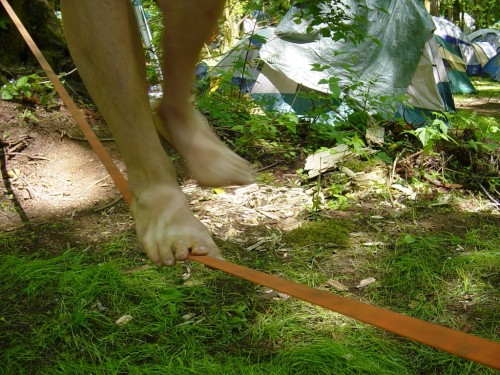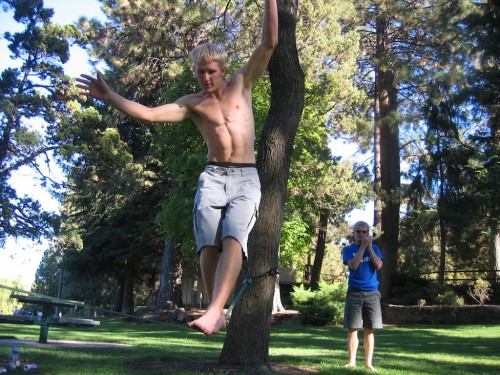In the interest of full disclosure, before I became a big-shot graduate student I was something of a dirtbag. I would guide wilderness trips, eat roots and berries, and participate in all sorts of dirtbag activities like frisbee, rock climbing and hacky sack. Indeed, I would also burn Nag Champa, wear hemp necklaces, and buy sarongs emblazoned with cultural symbols that I didn’t understand. I am proud to say, however, that I have never owned a pair of devil sticks.
I’ve been thinking a lot about slacklining for the last few days. Slacklining is a popular dirtbag sport, where you string up a one-inch thick piece of webbing between two trees. You pull it really tight and then you try to walk across it. If you’re really good, you walk across it, spin around, and then try to walk back. If you’re really, really good, you do flips and rolls and stuff. To get this good, however, you will need dreadlocks. A huge knotted mass of dreadlocks.
Slacklining is incredibly difficult when you first try to do it. Humans don’t naturally have what it takes, and even if you have incredible balance you still need to go through the difficult process of learning how to do it. Just standing on the slackline, even less walking on the slackline, can be challenging. During their first few attempts most people have this sort of “Elvis leg” thing going on, where the instant they put weight on their foot it shakes back and forth at an alarming rate. You put your foot on the slackline, you try to stand up, you shake it like Elvis for half a second, and you fall right off. Damn, eh?
Slacklining isn’t very complicated. Indeed, unless you have dreadlocks and are doing backflips and handstands, it’s just walking. Sure, walking on a one-inch surface that is incredibly unstable is very difficult to do, but it certainly isn’t complicated. The path towards mastery is through practice and muscle memory. Whether you’re aware of it or not, as you practice slacklining your brain is analyzing all the small muscle movements in your body. Over time it identifies the “Elvis leg” as an unproductive motion, and your muscle memory moves in to compensate. Before you know it the Elvis leg is gone, and you’re working on your first step. Then two steps. Then you’re going for the other end of the slackline.
It’s hard and frustrating and even I am not that good at it, but if you keep on practicing you’ll continue to unconsciously get better. With slacklining there isn’t a whole lot for your brain to do, but it’s a skill that you begin to internalize over time. In a way, this is how I feel my design education is progressing. It isn’t a perfect analogy, as I would argue that producing designs, especially simple designs, is extremely complicated. However, right now I don’t see any particularly clear path when it comes to solving a design problem, and so I find myself wasting all sorts of time pursuing dead ends.
I’ll spend two hours trying to put together an appealing three-color palette, only to scrap it entirely two days later in favor of something else. All creative design comes in fits and starts, of course, but instead of walking to the other end of the slackline, right now I’m just trying to stand up. Still floundering on my shaky Elvis legs, I have not yet had the practice necessary to eliminate these excess, unproductive motions. In learning the theory and motivations behind HCI design I hope to internalize these thoughts and techniques, and unconsciously weave them into the fabric of my design process.



One Comment
Dane, damnit – you make me want to pursue design as a career again. All your youthful idealism as we get older…
Seriously though, you leave me wanting to drink copious amounts of beer and pander on about the philosophy of “good” design.